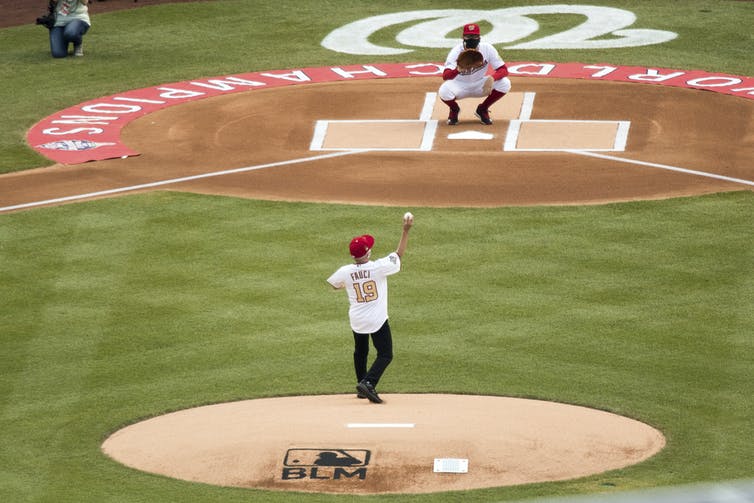His call to “Wear a mask” tops a list of 2020’s notable quotes. Brad Pitt portrayed him – and praised him – on “Saturday Night Live.” Time magazine named him a 2020 guardian of the year. Amazon features seven pages of T-shirts, mugs and more emblazoned with his face.
Longtime director of the National Institute of Allergy and Infectious Diseases Anthony S. Fauci has been everywhere in 2020.
Although perhaps only recently a household name, Fauci is no Tony-come-lately. Over the past four decades he’s played prominent roles as a scientist, physician, administrator and spokesman. You know what he’s been up to over the past several months. But what of his previous nearly 80 years? And what made him the figure he has become?
From Brooklyn to Washington
Fauci, son of a pharmacist, was born in Brooklyn on Dec. 24, 1940. He attended Regis High, a tuition-free Jesuit boys’ school. Passionate about basketball, he captained the high school team – despite his height of 5 feet 7 inches.
He then attended the College of the Holy Cross, in Massachusetts, choosing a premedical major combining humanities and science. He graduated first in his class from Cornell University Medical College and went on to complete a medical residency.
The Vietnam War was underway, and male med school graduates were required to serve their country. One option was the U.S. Public Health Service, which includes the National Institutes of Health, based outside Washington, D.C. Fauci entered a highly selective training program there. He’s worked at NIH essentially ever since.
At NIH, Fauci initially conducted specialized research on the immune system and related rare diseases – for example, one now termed granulomatosis with polyangiitis, in which blood vessels in the respiratory system and kidneys become inflamed. His work led to effective treatment of these previously largely fatal conditions.
The age of AIDS
As the 1980s arrived, what came to be called AIDS emerged. Fauci soon redirected his research to focus on the new disease. He accepted the directorship of NIAID in 1984, in part to increase its emphasis on AIDS.

AP Photo/Bob Daugherty
While continuing research and patient care, Fauci as institute director entered other realms. He testified repeatedly before Congress. He gained visibility in the media. He was confronted by AIDS activists – and eventually included them in setting priorities for developing treatments. Doing so set a precedent for involving patients in decisions about research on their diseases.
Fauci’s leadership has expanded over the years. He was among the main architects of the President’s Emergency Plan for AIDS Relief, or PEPFAR, a major program begun under President George W. Bush in 2003, to help control AIDS internationally. He provided leadership regarding responses to bioterrorism and to SARS, Zika and Ebola. He is a member of the Trump administration’s White House Coronavirus Task Force, and he has accepted President-elect Joe Biden’s invitation to serve as chief medical adviser.
Prolific in publication
Along the way, Fauci has authored or co-authored well over 1,000 journal articles, including more than 500 about AIDS. Of the articles, strikingly many appeared in top journals such as Science, Proceedings of the National Academy of Sciences and the New England Journal of Medicine. Fauci also is one of the editors of a major medical textbook.
Over the years Fauci published on topics that attest to his readiness for the coronavirus: past pandemics as well as emerging infectious diseases and how to confront them, even how to conduct clinical trials in the midst of an outbreak.
A recent study ranks Fauci as the 32nd most highly cited living researcher. His papers have been cited more than 50,000 times by other publications, and his journal articles have been mentioned tens of thousands of times in social media.
Sources of success
Clearly, Fauci is a remarkably successful scientist and a highly visible public figure. What factors seem to have contributed? Here are 10.
-
Smarts: Clearly Fauci is extraordinarily bright and knowledgeable. He has studied both science and humanities. The mix has fostered proficiency in lab and clinic, skill in communication and an ability to navigate the halls of power.
-
Integrity: “I believe I have a personal responsibility to make a positive impact on society,” he has stated. “I’ve tried to accomplish this goal by choosing a life of public service.” Strong values have directed his choices, such as that to remain at NIAID despite offers to become director of NIH or take more lucrative positions elsewhere.
-
Empathy: Fauci’s values include concern for others’ well-being. Upon being confronted by AIDS activists, he said, “I saw people who were in pain.” He cared for, and about, people with AIDS even while the disease still was tremendously stigmatized.
-
Flexibility: Fauci can pivot. He redirected his work with the emergence of AIDS, contributing importantly to the understanding and treatment of the disease. Despite insults from AIDS activist Larry Kramer, he developed a productive alliance and warm friendship with him.
-
Energy: Fauci has an exceptional work ethic and is blessed with amazing energy. Account after account details the staccato pace of his ultra-long days – rising before dawn, rushing from commitment to commitment with barely a break and answering email until late at night.
-
Trustworthiness: Fauci has earned credibility – through research and publication, impact on patient health and long service. In his communications, his values keep him focusing on the facts. An essay in the Washington Post terms him “the singular referee the country trusts” during the pandemic.
-
Connections: Adviser to six U.S. presidents and the current president-elect, Fauci has abundant ties in Washington among both politicians and the media. Some science reporters have covered his work since the 1980s.
-
Communication: Termed “the explainer-in-chief of the coronavirus epidemic,” Fauci is a master communicator. He knows how the media function. He explains clearly. He speaks in sound bites – think “we are likely going to see a surge upon a surge” of cases after the Thanksgiving holiday – and his comments are tweetable. He is accessible to the press. He listens as well as speaks.
-
Recognizability: Fauci has a distinctive look and voice. His name is unusual yet not unwieldy.
-
Teamwork: “It’s almost impossible to do anything meaningful without either leading a team or being part of the team,” Fauci has said. A photo of Fauci’s lab group shows some 80 members, including senior researchers. Highly regarded for his mentorship, Fauci even made himself available to an undergrad writing a thesis – and then commented extensively on the finished product.

AP Photo/Andrew Harnik
In many ways, Fauci has been the face of the fight against COVID-19 in the U.S. “If we’re going to get through this, we’ve got to all pull together as a country,” Fauci has stated. His blunt, evidence-based approach has helped make him famous in 2020. With any luck, he can lead the way to controlling COVID-19 in 2021.

